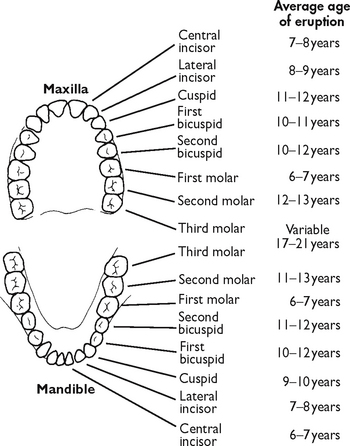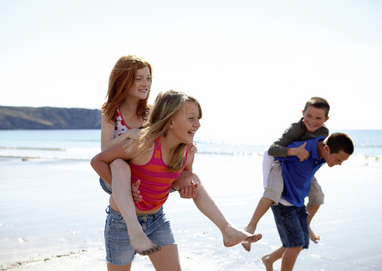The toddler
Toddlerhood ranges from the time when children begin to walk independently until they walk and run with ease, which is from 12 to 36 months of age. The toddler is characterised by increasing independence bolstered by greater physical mobility, language development and cognitive abilities. Toddlers are increasingly aware of their abilities to control and are pleased with successful efforts with this new skill. This success leads them to repeated attempts to control their environments. Unsuccessful attempts at control may result in negative behaviour and temper tantrums. These behaviours are most common when parents thwart the initial independent action. Parents cite these as the most problematic behaviours during the toddler years.
Physical changes
The rapid development of motor skills allows the toddler to participate in self-care activities such as feeding, dressing and toileting. In the beginning, the toddler walks in an upright position with a broad-stanced gait, protuberant abdomen and arms out to the sides for balance. Soon the toddler begins to navigate stairs, using a rail or the wall to maintain balance while progressing upwards, placing both feet on the same step before continuing. Success provides the courage to attempt the upright mode for descending the stairs in the same manner. Locomotion skills soon include running, jumping, standing on one foot for several seconds and kicking a ball. Most toddlers can ride tricycles, climb ladders and run well by their third birthday (Glasper and Richardson, 2010). Fine motor capabilities move from scribbling spontaneously to drawing circles and crosses accurately. By 3 years the toddler draws simple stick-people and can usually stack a tower of small blocks. Increased locomotion skills, the ability to undress, and development of sphincter control allow toilet training if the toddler has developed the necessary cognitive abilities. Parents often consult nurses for an assessment of readiness for toilet training. The nurse needs to remind parents to look for cues that the toddler is ready or interested in toileting and that patience, consistency and a non-judgmental attitude, in addition to the toddler’s readiness, are essential to successful toilet training.
The cardiopulmonary system becomes stable in the toddler years. The heart and respiratory rates slow, and the blood pressure varies slightly from infancy as shown in Table 20-5. The anterior fontanel closes between 12 and 18 months of age, ending the period of most-rapid growth of the skull and brain. Routine measurement of head circumference is recommended until 3 years of age.
The rate of increase in weight and length slows. By 2½ years the toddler weighs four times their birthweight and is approximately half of their adult height (Glasper and Richardson, 2010). Height during toddlerhood increases by about 7.5 cm a year, mainly as a result of increases in leg length.
Cognitive changes
From your reading of Chapter 19 you may recall that during toddlerhood children transition from Piaget’s sensorimotor stage to preoperational thought. Intellectual development advances and toddlers can comprehend themselves as a separate identity from others. They are able to obey simple instructions and can increasingly use language to communicate. Thinking during this stage is concrete; that is, the toddler is unable to reason, use logic or see things from another’s point of view.
Toddlers use symbols to represent objects, places and persons. This function is demonstrated when toddlers imitate the behaviour of another that they have viewed earlier, such as pretending to shave like Daddy or pretending their finger is a gun.
A child’s moral development is at the beginning stages during toddlerhood and is closely associated with their cognitive abilities. In Chapter 19 you read about moral development of children.
At this developmental stage, it is theorised that toddlers do not understand concepts of right and wrong. However, they do grasp the fact that some behaviours bring pleasant results (positive reinforcement) and others elicit unpleasant results (negative reinforcement).
Take the time to reflect upon cognitive and moral development of the toddler, and think about how a toddler’s understandings of the world and events within that world may affect the nursing care you provide. For example, an unpleasant procedure may be perceived as punishment for wrongdoing; if so, how would you approach such a situation?
Along with the development of preoperational thought and morality comes the development of language. The rate of speech development varies from toddler to toddler, with girls generally developing language at a faster pace than boys (Berk, 2007). It important that parents and nurses understand that a toddler will comprehend vocabulary to a much greater degree than they are able to express vocabulary (Hockenberry and Wilson, 2009), so it is important to remember to include the toddler when discussing their care and treatments. The 18-month-old toddler uses approximately 10 words. By 24 months of age the toddler has a vocabulary of up to 300 words and is generally able to speak in short sentences. ‘Who’s that?’ and ‘What’s that?’ typify questions asked during this period. Verbal expressions such as ‘Me do it’ and ‘That’s mine’ demonstrate the 2-year-old toddler’s use of pronouns and desire for independence and control, which again are important considerations for the nurse when planning care for toddlers and their families.
Psychosocial changes
According to Erikson, another theorist you read about in Chapter 19, a sense of autonomy emerges during toddlerhood. Toddlers strive for independence by using their developing muscles to do everything for themselves and become the master of their bodily functions. Their strong wills are frequently exhibited in negative behaviour when caregivers attempt to direct their actions. Temper tantrums may result when toddlers are frustrated by parental restrictions, as this is the stage of development when the child is trying to assert their autonomy (Berk, 2007). Toddlers that have some graded independence allowing them to do things that do not result in harm to themselves or others, such as dressing, will have this stage of development supported. Allowing some independence prevents them from doubting their ability to do certain things. Firm consistent limits, patience and support allow toddlers to develop socially acceptable behaviour and self-control (Berk, 2007).
The child continues to engage in solitary play during toddlerhood but also begins to participate in parallel play, which is playing beside rather than with another child. Toddlers who are just learning what belongs to them are often possessive of their toys. They learn the joy of sharing when they offer parents toys to hold and the parents express pleasure.
Socially, toddlers remain strongly attached to their parents and fear separation from them. In their presence they feel safe, and their curiosity is evident in their exploration of the environment.
Other health considerations during toddlerhood
Safety
The newly developed locomotion abilities and insatiable curiosity of toddlers make them a danger to their own wellbeing. Toddlers need close supervision at all times, and particularly when in environments that have not been childproofed. Poisonings occur frequently because toddlers near 2 years of age are interested in placing any object or substance in their mouths to learn about it. Removing or locking up all possible poisons, including plants, cleaning materials and medications, is a safe strategy and one that nurses can discuss with parents. These parental actions create a safer environment for exploratory behaviour. Toddlers lack awareness of the danger of water and their newly developed walking skills combine to make drowning a major cause of accidental death in this age group. Limit-setting is extremely important for toddler safety. Toddlers completely depend on their parents and carers for physical safety. Table 20-8 identifies developmental abilities acquired during this age period, and injury prevention strategies.
TABLE 20-8 INJURY PREVENTION DURING EARLY CHILDHOOD
Modified from Hockenberry MJ, Wilson D 2011 Wong’s Nursing care of infants and children, ed 9. St Louis, Mosby.
Health Perceptions
A toddler’s perception of their own health is limited by their cognitive capabilities. Toddlers are able to recognise internal body sensations but have difficulty pinpointing their location. Toddlers therefore often associate generalised responses with illness. Toddlers who deviate radically from their usual patterns of eating, sleeping or playing require assessment to determine whether these alterations have resulted from illness.
Nutrition
Nutritional requirements are increasingly met by solid foods from the food pyramid, and less from breast milk or breast-milk substitutes. The healthy toddler requires a balanced daily intake of bread and grains, vegetables, fruit, dairy products and proteins. Nurses can support parents through careful assessment of dietary intake and by discussing strategies that may assist the integration of a balanced range of foodstuffs in the toddler’s diet.
Toddlers who are ill, are undergoing surgery or have diseases involving ingestion, absorption or use of nutrients require special dietary considerations in consultation with a paediatric dietitian, as alterations in the types of foods and kilojoule requirements may be necessary. For example, a toddler on a strict vegetarian diet also requires careful planning to ensure an adequate, balanced protein intake.




